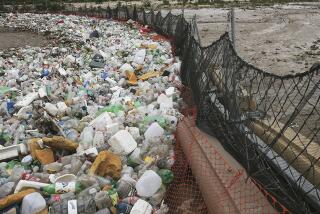Changing Lifestyles : Chilean Fish Village’s Latest Catch: Tourists : A former whaling center is reinventing itself with resorts and cafes to serve an increasingly affluent nation.
- Share via
QUINTAY, Chile — From the 1940s to the late 1960s, whaling ships towed their prey to a factory here, where hundreds of workers butchered the giant mammals for oil and animal feed. Rancid whale grease drifted over the waters of Quintay’s picturesque cove, and the rank odor of rottingflesh hung in the air.
When the whaling trade collapsed, the factory was closed, Quintay cleaned itself up and settled into the quiet routine of a small fishing village, where the catch of the day is measured in kilograms instead of tons.
Now life in Quintay is changing again.
Increasing waves of weekend and summertime tourists from Santiago, the Chilean capital, are giving the town an economic boost. With the construction of a $150-million resort nearby, the boost will become a boom.
Tourism and the resort project are a reflection of surging affluence in this South American country, whose economy has expanded by 24% in the last three years. Growing numbers of Santiago residents can afford holidays and vacations on the coast, and as a result, traditional beach resorts are being overrun.
The crowds are looking for new places to go. Many are discovering Quintay, which is profiting handsomely.
“Every year it has gotten better and better,” said Alex Tronche, a fisherman whose family owns a restaurant on the Quintay cove. The lunchtime tables were filled on a recent Saturday. Next door, a new restaurant was under construction.
All over town, cafes, guest houses and grocery stores have been popping up. Construction on the new resort, called Santa Augusta de Quintay, has added steam to development. The project already employs 200 workers and is drawing a stream of visitors interested in buying resort homes.
Eventually the complex is to have 1,500 houses and condominium apartments and a 40-room luxury hotel. There will be polo grounds, tennis courts and an 18-hole golf course. Streets are already being paved, and the first few buildings are going up.
The project is being financed by a group of French investors, headed by Yves Buhagiar, who also have real estate and commercial interests in France, Tahiti, New Caledonia and French Guyana.
Fisherman Tronche, 28, knows that greater change will follow.
“The activity is going to be good,” he predicted.
But he and others wonder whether all of the changes will be beneficial for Quintay, which now has about 800 permanent residents. For example, Tronche expects increased demand for labor to drive up wages and increase operating costs at his family’s restaurant. Others worry that hordes of tourists will spoil the peaceful atmosphere.
Tito Bernal, 64, remembers when the whaling station was operating at full tilt in the 1950s, employing more than 1,000 workers and butchering as many as 10 whales a day. Blue, sperm and other whales were plentiful in this corner of the Pacific, and the Quintay whaling company hunted them with more than a dozen 150-foot ships.
Workers were brought from other areas to operate the factory.
“It was badly paid and very filthy work,” Bernal said. “They were always covered with grease and blood.”
The workers lived in a company camp and added little to Quintay’s livelihood.
Tourists shunned the town because it was “very disagreeable, stinking. . . . There was whale grease all over the beach,” Bernal recalled. Whale carcasses waiting to be butchered floated in the water, often decomposing.
Sitting on a bench in the yard of his old wooden house, on a hillside above the craggy shoreline, Bernal recalled that the whales became increasingly scarce in the 1960s. Finally, the factory was closed.
Today it is a massive jumble of crumbling concrete encrusted on the rocky shore south of town. In a corner of the old complex, however, there is new life.
Last year, Santiago’s Andres Bello National University installed a marine science laboratory there. Among the small lab’s activities is a hatchery for seafood, such as scallops and sea urchins. Those products, exported by Chile at premium prices, have excellent commercial potential, said Gustavo Vega, who heads the lab.
Vega said the lab is cooperating with the Quintay fishermen’s association, supplying material and technical advice for seafood farming. In one project, the fishermen have begun growing scallops in wire cages.
The association also established a 250,000-acre preserve for sea urchins, crabs and mollusks, called locos and lapas --prized as delicacies in Asia. “We’ve already harvested locos , 110,000 of them in the first harvest last year,” Bernal said.
While Bernal and other fishermen have readily accepted such improvements in their way of life, some are ambivalent about changes that will come with the Santa Augusta resort. When the project paves the 17-mile dirt road that winds into Quintay from the nearest highway, day-trippers with lunch baskets are likely to pour into town, leaving litter but little money, Bernal fretted.
On the other hand, he said, the upscale crowd of Santa Augusta itself should invigorate the local economy. Developers say the complex will eventually provide direct employment for about 500 people, and visitors and residents eating at Quintay restaurants and buying seafood products from the local fishermen will boost incomes of other townspeople.
“With the tourist complex, Quintay will be a wonder,” Bernal said. “Where we get hurt is in our tranquillity.”
More to Read
Sign up for The Wild
We’ll help you find the best places to hike, bike and run, as well as the perfect silent spots for meditation and yoga.
You may occasionally receive promotional content from the Los Angeles Times.





